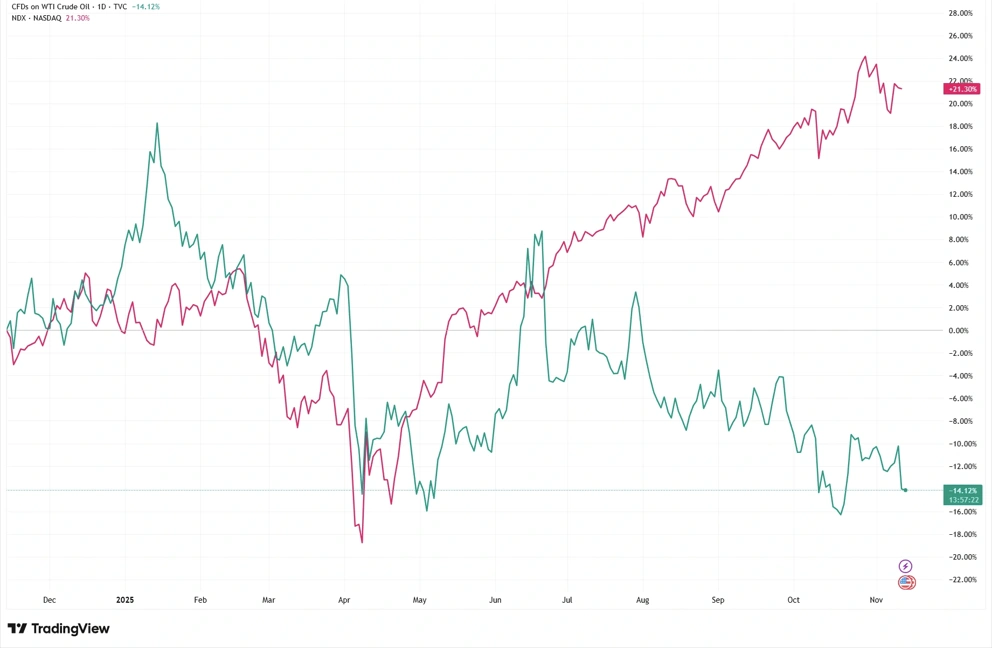Why Oil Prices Influence Everything – Even Your Tech Stocks
Oil is often called the heartbeat of global activity. It underpins around 3% of global GDP and is found “in everything from personal protective equipment, plastics, chemicals and fertilisers through to … fuel for transportation”. So when oil prices move, the effects ripple far beyond energy producers. Even technology firms feel the tremors. Let’s see how.
Oil as a Cost Input Across the Economy
Oil touches nearly every industry. Its price feeds directly into transport and logistics (trucks, planes, ships need fuel), manufacturing, and the production of plastics and chemicals. In fact, petroleum is the primary feedstock for most plastics, so oil price swings “directly drive production costs and supply-chain expenses”.
- Transport and shipping: Higher oil means pricier petrol and diesel. That pushes up the cost of moving goods, from farm produce to consumer electronics.
- Manufacturing and plastics: Many factory inputs derive from oil. When oil rises, plastics and material costs climb along with it.
- Consumer goods and services: The extra costs don’t stay in one pocket. High oil prices “add to the costs of doing business… Whether it is higher cab fares, more expensive airline tickets, the cost of apples shipped from California, or new furniture shipped from China, high oil prices can result in higher prices for seemingly unrelated products and services”.
In short, every big oil price move alters the costs of production and logistics across sectors. That squeeze on profit margins eventually shows up in corporate earnings reports, even for firms far from the oilfields.
Oil and Inflation: The Chain Reaction
Rising oil prices trigger a familiar chain reaction through the economy and markets:
- Higher costs ⇒ Inflation: Oil is a major economic input, so when crude rises it adds to both producer and consumer inflation. Gasoline and transport costs go up, and higher petroleum-based material costs (plastics, chemicals) sweep into the prices of many goods.
- Central bank response: As inflation picks up, central banks often tighten policy (or delay rate cuts). In practice, this means short-term and long-term interest rates tend to rise.
- Rising yields hit growth stocks: Higher interest rates translate into higher bond yields. Since stock valuations (especially for tech firms) are based on the present value of future earnings, higher yields tend to compress those valuations. In other words, “when the yield is low, it can boost stock prices because the present value of future earnings is higher. A higher yield can lead to lower stock valuations”.
In simple terms, an oil-driven rise in inflation can force interest rates up, which in turn makes expensive growth stocks (with earnings far in the future) look less attractive. Tech stocks, often trading on heavy forward multiples, feel that squeeze acutely.
Oil vs Tech: A Year of Divergence

Source: TradingView. All indices are total return in US dollars. Past performance is not a reliable indicator of future performance. Data as of 12 November 2025.
Oil down, tech up. This chart shows how falling crude prices in 2025 aligned with rising NASDAQ performance – a classic example of how oil shocks can shift risk appetite.
Risk Sentiment and the Growth vs Safety Shuffle
Beyond costs and inflation, oil moves affect investor psychology. A sudden oil spike can feed into a risk-off mood. When commodity-driven inflation looks urgent, traders often rotate out of high-flying tech names and into defensive bets (utilities, consumer staples, or government bonds). Conversely, when oil calms down, risk appetite can return.
Analysts even call the oil price a macro signal: if oil-driven inflation is tame, risk assets (tech and growth stocks) tend to get a boost. One recent note observed that an easing energy-price pressure would likely send money from energy back into sectors like tech and AI, which “may benefit from weaker commodity input inflation”. In short, when oil fears subside, high-multiple tech stocks often rally. And when oil fears spike, tech can sell off faster than most.
Oil as a Barometer of Global Growth
Oil also acts as a real-time barometer of the global economy. When economies roar ahead, oil demand and prices usually rise. By contrast, steep declines in oil prices often signal economic slowdown. (For example, in 2020 oil demand plunged and prices even went negative amid COVID lockdowns.)
Either way, big oil moves reshape growth expectations. A sharp oil rise can choke demand (pushing up costs and hurting consumer spending), while a collapse in oil might reflect weak growth. In both cases, corporate earnings forecasts shift. And that reverberates through valuations across all sectors. Even tech companies, whose costs seem mostly about chips and software, are ultimately valued in the same economy where oil factors into inflation, interest rates and demand.
Bottom Line
Oil is much more than just another commodity chart. It interlinks with inflation, borrowing costs, production expenses, investor risk appetite and the global growth outlook. As investors, we ignore oil’s story at our peril. Tech may sit worlds away from the oilfields, but their share prices dance to the beat of the same global machinery. In practice, that means savvy traders treat oil price moves not as isolated blips, but as a macro indicator of broader market sentiment. Watch it carefully.. it could reshape your entire portfolio’s risk landscape!